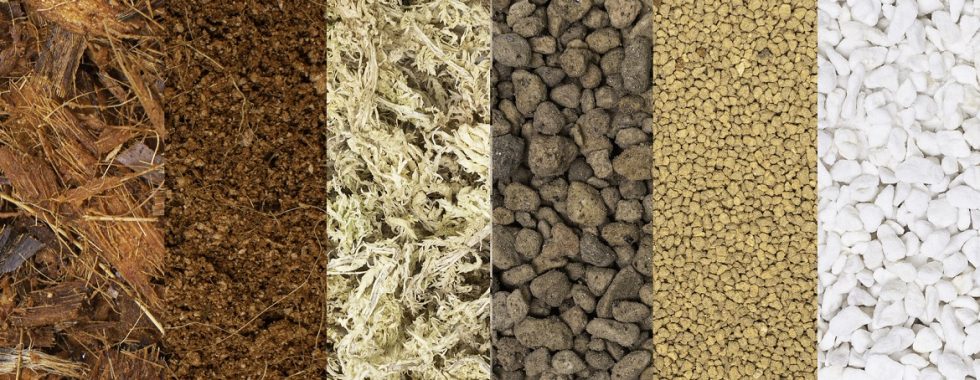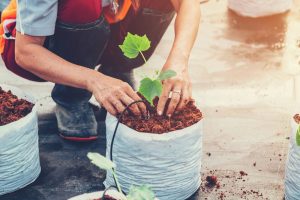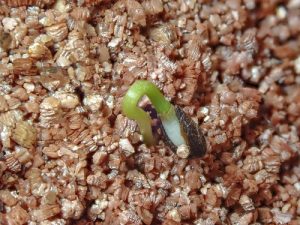Growing media – Properties, benefits and usage
Growing media, also known as growth substrates, play a crucial role in modern horticulture. They provide the necessary support, aeration, moisture and nutrients for plant roots, directly impacting plant health and productivity.
Physically, growing media vary in texture, porosity, and particle size, influencing their ability to retain water and provide aeration. Chemically, properties such as pH, cation exchange capacity (CEC), and nutrient content determine the media’s ability to supply essential minerals to plants. For instance, substrates with high CEC can hold and exchange more nutrients, enhancing plant growth.
In recent years, the demand for sustainable and efficient farming practices has increased. Therefore, it becomes more important for growers and agronomists to understand the properties, benefits, and uses of different growing media.
Types of Growing Media
Coco Peat
Coco coir is derived from the fibrous husks of coconuts. This organic growing medium has excellent water retention and aeration properties, making it a popular choice among growers. Its has a neutral to slightly acidic pH level (5.5-6.5), and it has a moderate electrical conductivity that growers can adjusted with nutrient solutions. Coco coir has a water holding capacity of between 60-70%, and its cation exchange capacity (CEC) is 60-130 meq/100g. Therefore, it retains nutrients effectively.
Coco coir is renewable and environmentally friendly, as it utilizes coconut by-products. It promotes healthy root development due to its high aeration and moisture retention capabilities and is naturally resistant to pathogens and pests. Coco coir is ideal for hydroponic systems, seed starting, and container production. It is also used as a soil amendment to improve texture and moisture retention.
Peat Moss
Peat moss is an organic material harvested from peat bogs, known for its lightweight and high water retention capabilities. It has an acidic pH (3.5-4.5), often requiring lime to adjust the pH for most plants. Peat moss can hold up to 60-70% water and has a high cation exchange capacity (CEC) of 100-200 meq/100g. These properties make it excellent at retaining nutrients.
Peat moss provides consistent moisture levels and improves soil structure and aeration when used as a soil amendment. It is sterile and free from weed seeds and pathogens, promoting healthy plant growth. Peat moss is commonly used in seed starting, soil amendment, and hydroponic systems, making it ideal for plants that require consistent watering.
Perlite
Perlite is a volcanic glass that expands when heated, creating a lightweight and porous material. It is widely used in horticulture for its excellent drainage and aeration properties. It has a neutral pH (7.0), a water holding capacity of 20-50%, and a low cation exchange capacity (CEC) of 1-5 meq/100g.
By enhancing drainage and aeration, perlite reduces the risk of root diseases caused by excess moisture. It is sterile and inert, free from pests and diseases, and lightweight, making it easy to handle and mix with other growing media. Growers use perlite as a soil amendment, in hydroponic systems, and for container gardening, particularly for plants that require well-drained soil conditions
Vermiculite
Vermiculite is a hydrated magnesium-aluminum-iron silicate that expands when heated, providing good water retention and aeration properties. It has a neutral to slightly alkaline pH (7.0-7.5), a high water holding capacity of 60-90%, and a cation exchange capacity (CEC) of 100-150 meq/100g.
Vermiculite holds moisture and nutrients well, reducing the frequency of watering and fertilization. It enhances root growth and seed germination due to its high water retention and aeration. Vermiculite is commonly used in seed starting, as a soil amendment, and in hydroponic systems, making it ideal for seedlings and young plants.
Rockwool
Rockwool is made from molten rock spun into fibers, providing excellent aeration and water retention. It has a neutral pH but often requires pre-treatment to stabilize. Rockwool has a high water holding capacity of 70-80% and a low cation exchange capacity (CEC) of 1-10 meq/100g.
Rockwool provides consistent and uniform growth conditions, essential for commercial production. It is inert and free from pests and diseases. It, therefore, reduces the need for chemical treatments. Rockwool is reusable after proper cleaning, making it a cost-effective option in the long run. It is ideal for hydroponic systems and commercial greenhouse production, particularly for high-value crops that require precise growing conditions.
Red Ash (Scoria)
Red ash, also known as scoria or volcanic rock, is a type of volcanic rock that is lightweight and porous. It has a neutral to slightly alkaline pH (7.0-8.0), a low to moderate water holding capacity, and a low cation exchange capacity (CEC) of 5-15 meq/100g.
Red ash enhances drainage and aeration, preventing root diseases caused by excess moisture. It is lightweight and durable and, therefore, easy to handle and mix with other growing media. Red ash is naturally sterile, reducing the risk of introducing pests and diseases. It is commonly used as a soil amendment to improve drainage and aeration, ideal for succulent and cacti mixes, and in hydroponic systems.
Comparison Table of Growing Media
| Property/Medium | Coco Coir | Peat Moss | Perlite | Vermiculite | Rockwool | Red Ash (Scoria) |
| pH | 5.5-6.5 | 3.5-4.5 | 7.0 | 7.0-7.5 | Neutral | 7.0-8.0 |
| Water Holding Capacity | 60-70% | 60-70% | 20-50% | 60-90% | 70-80% | Low-Moderate |
| Cation Exchange Capacity (CEC) | 60-130 meq/100g | 100-200 meq/100g | 1-5 meq/100g | 100-150 meq/100g | 1-10 meq/100g | 5-15 meq/100g |
| Aeration | Good | Good | Excellent | Good | Excellent | Excellent |
| Sterility | High | High | High | High | High | High |
Recommended Growing Media Mixtures
Seed Starting Mix
Components: Coco Coir (50%) and Perlite (50%)
Benefits: Coco coir provides excellent water retention and a neutral pH, promoting healthy root development. Perlite enhances aeration and drainage, preventing seedling rot.
Use Case: Ideal for starting seeds in trays or small pots, providing a balanced environment that supports germination and early growth.
Potting Mix for Container Gardening
Components: Peat Moss (60%) and Perlite (40%)
Benefits: Peat moss offers excellent water retention, providing consistent moisture. Perlite improves drainage and prevents compaction.
Use Case: Suitable for a wide range of container-grown plants, including flowers, herbs, and vegetables.
Succulent and Cacti Mix
Components: Red Ash (Scoria) (70%) and Perlite (30%)
Benefits: Red ash provides excellent drainage and aeration, crucial for succulents and cacti. Perlite enhances drainage, preventing root rot.
Use Case: Ideal for growing succulents and cacti, which require well-draining soil to thrive.
Hydroponic Mix
Components: Rockwool (70%) and Perlite (30%)
Benefits: Rockwool provides consistent and uniform growth conditions, excellent water retention, and aeration. Perlite improves drainage and aeration within the hydroponic system.
Use Case: Hydroponic systems require precise control over moisture and aeration. Therefore, this mix is ideal for this kind of systems, especially for crops such as lettuce, herbs, and other leafy greens.
General Soil Amendment Mix
Components: Peat Moss (50%) and Red Ash (Scoria) (50%)
Benefits: Peat moss provides excellent water retention and improves soil texture. Red ash enhances drainage and aeration, preventing soil compaction and improving root health.
Use Case: A good mixture for container plants.




